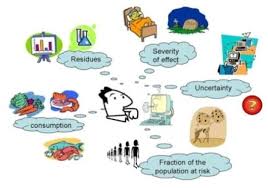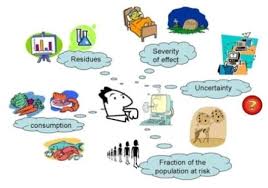In recent years, the problem of toxic metal contamination in different foodstuffs has received considerable attention among the researchers. With the increase of environmental pollution, the contamination level of the metals also increases in the food chains. These metals may be entered into human body through foods. When the amount of these metals is higher than the body tolerance limit, these may be accumulated into some target organ of human body. Which may lead some adverse health affects in course of time. In context with the circumstances, it is needful to assess the dietary intakes of some toxic metals such as Pb, Cd, Cr, Ni and As for the general population.
A variety of methods are available for the estimation of trace metal intake by human from foods. Many of these methods are originated from dietary food surveys and have recently been adopted in food toxicology. Here, dietary intakes of toxic metals from food sources have been estimated in the following ways (i) the amount of some toxic metals (Pb, Cd, Cr, Ni and As) was determined in different foodstuffs of Chittagong city area, Bangladesh (Chapter-3 to Chapter-8), and then (ii) the survey data of BBS (Bangladesh Bureau of Statistics) household’s composition of average diet of the Bangladeshi was used for the calculation of dietary intakes of these toxic metals (BBS, 1998). The dietary intake of a metal is the sum of the metal from all the food consumed.
Standards for metal intake through food
Toxic metals intake limit of a man from foods was fixed up by many environmental control organizations like the Joint FAO, WHO Expert Committee on Food Additives (JECFA), the Australia – New Zealand Food Authority (ANZFA), the U.S. Food and Drug Administration (USFDA), the Codex Alimentarius Commission (CAC) and the Agency for Toxic Substances and Disease Registry (ATSDR). For an example, JECFA determined the permissible daily intake of Pb as 0.05 mg kg-1 of body weight week-1 i.e. a man having weight 60 kg could intake 0.43 mg of Pb day-1 from all sorts of foodstuffs. WHO stated that the maximum intake of Cd and As from all foods is 0.2 and 0.7 mg day-1, respectively. The permissible levels of Cr and Ni intake are 0.2 and 0.3 mg day-1, respectively.
Composition of average diet in Bangladesh
BBS (Bangladesh Bureau of Statistics) survey (1995-96) of households in Bangladesh for the per capita daily food intake is given in Table 9.1.
Table 9.1: Average per capita (urban) daily intake of food items
Food groups | daily intake (g) |
| Cereals (Rice) Potato Vegetables Pulses Milk/milk products Meat/poultry and eggs Fish Spices(onion, chilies and others) Edible oils Fruits Sugar Miscellaneous | 442.1 64.4 142.9 19.4 42.1 30 51.7 45.4 17 38.8 10.1 26.6 |
Total | 930.8 |
Results and discussion
The concentration of some trace metals of different foodstuffs for the period of 2008-2010 was determined. Their results and findings have been discussed in previous chapters. These results and the consumption data of BBS (Table 9.1) are used in the calculation of daily intake of the toxic metals. The limit of detection (LOD) was unknown for many samples, the concentrations of undetected samples were considered to be zero. Hence, the calculated intakes in the current study are at the lower range. The calculated daily intakes of these toxic metals from different foods are presented in Table 9.2 to 9.8. The total dietary intake of these metals is estimated by combining data of concentrations of the metals in different foods and the consumption of these products as shown in Table 9.9. The results of the calculation have also been used to determine the contributions of the various food groups into the total intake (Table 9.10 and Figure 9.1 to Figure 9.5). The estimated dietary intake of these toxic metals was compared with an established reference health standard (Table 9.9) and the data of other countries of the world (Table 9.11).
Table 9.2 showed the total mean dietary intake of toxic metals from meat and egg. The mean concentration of Pb, Cd, Cr, Ni and As were 7.41, 0.96, 0.57, 4.17 and 0.004 mg kg-1, respectively (Table 3.5 and Table 3.8). The mean consumption of meat and egg by the urban population of Bangladesh is 30 g day-1 (Table 9.1). The intake levels of Pb, Cd, Cr, Ni and As from meat were calculated to be 0.22, 0.03, 0.02, 0.13 and 0.002 mg person day-1, respectively (Table 9.2).
Table 9.2: Dietary intake of toxic metals from meat and egg
Metal
| Mean value (mg kg-1) | Mean consumption (g person day-1) | Amount of intake (mg person day-1) | ||||
Pb | 7.41 | 0.2223 | |||||
Cd | 0.96 | 0.0288 | |||||
Cr | 0.57 | 30 | 0.0171 | ||||
Ni | 4.17 | 0.1251 | |||||
As | 0.08 | 0.0024 | |||||
Table 9.3 indicated the mean dietary intake of toxic metals from fruits. The average concentration of Pb, Cd, Cr, Ni and As was 1.45, 0.014, 0.96, 0.73, and 0.07 mg kg-1, respectively (Table 5.1). The mean consumption of fruits by the urban population is 38.8 g person day-1(Table 9.1). The intake levels of Pb, Cd, Cr, Ni and As from fruits were calculated to be 0.06, 0.001, 0.04, 0.03 and 0.003 mg person day-1, respectively (Table 9.3).
Table 9.3: Dietary intake of toxic metals from fruits
| Metal
| Mean value (mg kg-1) | Mean consumption (g person day-1) | Amount of intake (mg person day-1) | ||||
Pb | 1.45 | 0.0563 | |||||
Cd | 0.014 | 0.0005 | |||||
Cr | 0.96 | 38.8 | 0.0372 | ||||
Ni | 0.73 | 0.0295 | |||||
As | 0.07 | 0.0031 | |||||
Table 9.4 showed the mean dietary intake of toxic metals from pulses. The mean concentration of Pb, Cd, Cr, Ni and As in pulses were 0.73, 0.11, 0.45, 3.19 and 0.02 mg kg-1, respectively (Table 4.6). The mean consumption of pulses by the urban population is 19.4 mg person day-1 (Table 9.1). The intake levels of Pb, Cd, Cr, Ni and As from pulses were calculated and the values were 0.01, 0.002, 0.01, 0.06 and 0.0004 mg person day-1, respectively (Table 9.4).
Table 9.4: Dietary intake of toxic metals from pulse
| Metal
| Mean value (mg kg-1)
| Mean consumption (g person day-1)
| Amount of intake (mg person day-1)
| ||||
Pb | 0.73 | 0.0142 | |||||
Cd | 0.11 | 0.0021 | |||||
Cr | 0.45 | 19.4 | 0.0087 | ||||
Ni | 3.19 | 0.0619 | |||||
As | 0.02 | 0.0004 | |||||
Table 9.5 showed the dietary intake of toxic metals from spices. The mean concentration of Pb, Cd, Cr, Ni and As in spices (Chili, onion, garlic and others) was 1.16, 0.19, 17.81, 2.82 and 0.11 mg kg-1, respectively (Table 4.7). The mean consumption of spices by the urban population is 45.4 g person day-1 (Table 9.1). The intake levels of Pb, Cd, Cr, Ni and As were found to be 0.05, 0.01, 0.81, 0.13 and 0.005 mg person day-1, respectively.
Table 9.5: Dietary intake of toxic metals from spice
Metal
| Mean value (mg kg-1)
| Mean consumption (g person day-1)
| Amount of intake (mg person day-1)
| ||||
Pb | 1.16 | 0.0527 | |||||
Cd | 0.19 | 0.0086 | |||||
Cr | 17.81 | 45.4 | 0.8086 | ||||
Ni | 2.82 | 0.1281 | |||||
As | 0.11 | 0.005 | |||||
Table 9.6 exhibited the dietary intake of toxic metals from cereal. The mean concentration of Pb, Cd, Cr, Ni and As in cereal was 1.88, 0.15, 0.97, 1.29 and 1 mg kg-1, respectively (Table 6.7). The mean consumption of cereal by urban population is 442.1 g person day-1 (Table 9.1). The intake levels of Pb, Cd, Cr, Ni and As were calculated and found 0.83, 0.07, 0.43, 0.57 and 0.44 mg person day-1, respectively (Table 9.6).
Table 9.6: Dietary intake of toxic metals from cereal
Metal
| Mean value (mg kg-1)
| Mean consumption (g person day-1)
| Amount of intake (mg person day-1)
| ||||
Pb | 1.88 | 0.8311 | |||||
Cd | 0.15 | 0.0663 | |||||
Cr | 0.97 | 442.1 | 0.4288 | ||||
Ni | 1.29 | 0.5703 | |||||
As | 1 | 0.4421 | |||||
Table 9.7 pointed out the dietary intake of toxic metals from edible oil (Soybean oil). The mean concentration of Pb, Cd, Cr, Ni and As in Soya bean oil was 0.13, 0.02, 0.02, 0.04, 0.01 mg kg-1, respectively (Table 8.3). The mean consumption of edible oil is 17 g person day-1 (Table 9.1). The intake levels of Pb, Cd, Cr, Ni and As from the Soya bean oil were calculated to be 0.002, 0.0003, 0.0003, 0.001 and 0.0002 mg person day-1, respectively (Table 9.7).
Table 9.7: Dietary intake of toxic metals from oil
Metal
| Mean value (mg kg-1) | Mean consumption (g person day-1) | Amount of intake (mg person day-1) | ||||
Pb | 0.13 | 0.0022 | |||||
Cd | 0.02 | 0.0003 | |||||
Cr | 0.02 | 17 | 0.0003 | ||||
Ni | 0.04 | 0.0007 | |||||
As | 0.012 | 0.0002 | |||||
Table 9.8 showed the dietary intake of toxic metals from fishes. The mean concentration of Pb, Cd, Cr, Ni and As in fishes were found to be 0.63, 0.1, 0.59, 0.78 and 0.48 mg kg-1 respectively [9, 10]. The average consumption of fish is 51.7 g person day-1 (Table 9.1). The intake levels of Pb, Cd, Cr, Ni and As from fishes were calculated to be 0.03, 0.005, 0.03, 0.04 and 0.02 mg person day-1, respectively (Table 9.8).
Table 9.8: Dietary intake of toxic metals from Fish (From literature)
Metal
| Mean value (mg kg-1) | Mean consumption (g person day-1) | Amount of intake (mg person day-1 | ||||
Pb | 0.63 | 0.0326 | |||||
Cd | 0.1 | 51.7 | 0.0052 | ||||
Cr | 0.59 | 0.0305 | |||||
Ni | 0.78 | 0.0403 | |||||
As | 0.48 | 0.0248 | |||||
Table 9.9 showed the dietary intake of toxic metals from various food commodities (meat and egg, pulses, spices, fruits, cereal, oil and fishes). The total intake of Pb, Cd, Cr, Ni and As from this various foods were found to be 1.2, 0.12, 1.34, 0.96 and 0.47 mg person day-1, respectively.
Table 9.9: Total dietary intakes of toxic metals from various food commodities
| Foods | Pb | Cd | Cr | Ni | As |
| Cereal | 0.83 | 0.07 | 0.43 | 0.57 | 0.44 |
| Pulses | 0.01 | 0.002 | 0.01 | 0.06 | 0.0004 |
| Spices | 0.05 | 0.01 | 0.81 | 0.13 | 0.005 |
| Meat and egg | 0.22 | 0.03 | 0.02 | 0.13 | 0.002 |
| Fruits | 0.06 | 0.001 | 0.04 | 0.03 | 0.003 |
| Edible oil | 0.002 | 0.0004 | 0.0004 | 0.001 | 0.0004 |
| Fishes | 0.03 | 0.01 | 0.03 | 0.04 | 0.02 |
| Total intake | 1.202 | 0.123 | 1.34 | 0.961 | 0.471 |
| WHO RMTI | 0.43 | 0.2 | 0.2 | 0.3 | 0.7 |
RMTI: Recommended Maximum Tolerable Intake
The maximum intakes of Pb was found in cereals (0.83 mg person day-1) followed by meat and egg (0.22 mg person day-1). The total intake of lead from various foods was 1.20 mg person day-1, which was 2.8 times higher than the WHO recommended limit of 0.43 mg day-1 [11, 12]. The elevated intake of Pb from food would be reflected in blood by various population groups in the urban. Many researchers reported that the inhabitants of urban bears higher amount of lead in blood than the recommended value.
In case of cadmium, the order of dietary intake was the same as lead i.e. the first and foremost source being cereal (0.07 mg person day-1) followed by meat (0.03 mg person day-1) and fishes (0.01 mg person day-1). The total cadmium intake from various foods was 0.123 mg person day-1, which was quite reasonable as compared to the recommended daily intake (0.2 mg person day-1).
The highest intake of chromium was found in spices (0.81 mg person day-1). Cereal was the second highest source of chromium intake (0.43 mg person day-1). Both the food items contain higher amount of chromium as compared to the recommended amount (0.2 mg person day-1). But the intake of chromium from other samples was quite reasonable. The total dietary intake was found as 1.34 mg person day-1, which was 6.7 times higher than the WHO recommended limit.
Like lead and cadmium, the main source of Ni was found in cereal (0.57 mg person day-1). Other main sources of Ni were meat and spices (0.13 mg person day-1). The intakes of Ni from fruits, pulses and fishes were within the range of 0.03 – 0.06 mg person day-1, which was reasonable as compared to WHO recommend MTI limit (0.30 mg person day-1). Cereal also is the main source for arsenic intake (0.44 mg person day-1). The contribution of other food items in daily intake of arsenic is very negligible. The total daily intake of arsenic is 0.47 mg person day-1, which was far below the MTI value of 0.7 mg person day-1.
The intake of heavy metals varies considerably from place to place. The variation of heavy metals intake from foods may be the result of different food consumption habits and varying environmental condition. The food consumption depends on several socio economic and physiological variables; for example, age, occupation and the living environment. Heavy metals particularly Pb and Cd intake in the old age (60-64 year) has been reported to be significantly less than young age groups (30-39 years) [2]. This suggests that the amount of food consumed is the major factor contributing to the difference in heavy metal intake between age groups. Heavy metal concentrations in foods vary due to varying deposition of pollutants, concentration of metals in fertilizer, insecticide and soil conditions. In addition, smoking and urban air increase the total exposure to heavy metals.
An overall view of the Table 9.9 indicated that cereals were the major sources of toxic metal intake from the investigated food items. Spices were also dominant sources of chromium and nickel intake. Many researchers reported that vegetable and cereal are the main principal sources of heavy metal intake [19, 20].
Table 9.10 and the Figures 9.1, 9.2, 9.3, 9.4 and 9.5 showed the percentage of contribution of the foodstuffs for the estimated heavy metals. These Figures showed that cereals were the principal sources of Pb, Cd, Ni and As intake in the body (59-94%), while spices were the major sources of Cr intake in the body (61%).
Table 9.10: Toxic metals intake contributed by various food commodities (%)
Foods | Pb | Cd | Cr | Ni | As |
| Cereal | 69.05 | 56.77 | 32.08 | 59.31 | 93.5 |
| Pulses | 0.832 | 1.622 | 0.746 | 6.243 | 0.085 |
| Spices | 4.16 | 8.11 | 60.43 | 13.53 | 1.062 |
| Meat | 18.3 | 24.33 | 1.492 | 13.53 | 0.425 |
| Fruits | 4.992 | 0.811 | 2.984 | 3.122 | 0.637 |
| Edible oil | 0.166 | 0.243 | 0.022 | 0.104 | 0.042 |
| Fishes | 2.496 | 8.11 | 2.238 | 4.162 | 4.25 |
It must be borne in mind that the trace metal content of the food commodities was calculated on fresh weight bases. It has been reported that trace metal loss during cooking varies from 10 – 30 percent. If this loss of heavy metal is considered then the intake of these metals will reduce by 10 – 30 %.
Table 9.11 showed the comparison of Pb, Cd, Cr, Ni and As intake from foods reported by others in various countries of the world [20, 21-32]. The study revealed that the intake of Pb from foods in Chittagong population was higher than those from the other countries. The intake of Cd in the population of the city of Chittagong was less than those from China [20] but 2-12 times higher than the reported values of the other countries. Though, the intake of Cd in the Chittagong was higher than the reported values of many other cities but the intake level of Cd was within the permissible limit. In case of Cr, the intake was lower than Iran but significantly higher than United Kingdom. The intake of As from food in Chittagong is comparable to that of Japan and Brazil but 8-16 times higher than the reported values of other countries. The intake of As from food was below the WHO recommended MTI value.
Table 9.11: Dietary intake of toxic metals in various countries (mg person day-1) [20-32]
Country | Pb | Cd | Cr | Ni | As |
| Australia | 0.06-0.1 | 0.03-0.06 | |||
| Canada | 0.05 | 0.06 | |||
| China | 0.37- 0.41 | ||||
| India | 0.143 | 0.06 | |||
| Japan | 0.08-0.13 | 0.04-0.06 | 0.18 | ||
| U.S.A | 0.06-0.11 | 0.03-0.04 | |||
| Brazil | 0.14-0.16 | ||||
| UK | 0.02-0.06 | 0.04-0.07 | 0.06 | ||
| Germany | 0.01- 0.03 | 0.01- 0.02 | |||
| Iran | 1.72* | ||||
| Greece | 0.09- 0.13 | ||||
| Present work | 1.202 | 0.123 | 1.34 | 0.961 | 0.471 |
* This value comes from only vegetables
Conclusion
It can safely be concluded that the intake of Pb, Cr and Ni from food by the residents of Chittagong city was higher than the FAO/WHO maximum tolerance intake limit and the main source of intake of these metals was the contaminated and polluted food items. These food items were cereals, spices and meats contributing largely in the daily intake of the metals. The contamination of the foods is done mainly by untimely and improper use of fertilizers, insecticides, germicides and fungicides during their growth in the fields and due to the use of chemicals for storage purpose.

















